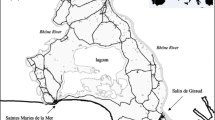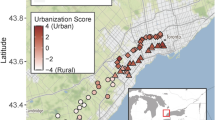Abstract
Land use by native and introduced dandelion groups in man-made habitats was studied at 7090 survey points in the Tokyo metropolitan area, Japan, in order to clarify the replacement phenomenon occurring among dandelions. In the center of Tokyo, where the native group was rare, the percentage occurrence of the introduced group was lower than in other regions, whereas in the outskirts of Tokyo, both groups showed much higher occurrence. Roadsides, vacant areas and urban land-use categories were significantly favorable for growth of the introduced group, whereas preserved or rural land use was more favorable for the native group. Seed fertility in the introduced group was more than 80%, and was independent of population size, whereas in the native group it was not as high, and for a small population was dependent on population size, being stable at about 70% in populations larger than 70 plants. Thus, both large populations and solitary plants in the introduced group appeared to act as seed sources, making it likely that the introduced group will spread increasingly through roadsides and urban land, which are becoming more widespread as a result of urbanization. It is feared that, unless deliberately retained, the amount of preserved or rural land which has fostered large populations of the native group will further decrease with urbanization and other forms of development, thus depleting the seed sources and reducing the population.
Similar content being viewed by others
References
Anderson, J. P. 1961. Flora of Alaska and adjacent parts of Canada. 543 pp. Iowa State Univ. Press, Iowa.
Grime J. P. &Lloyd, P. S. 1973 An ecological atlas of grassland plants. 192pp. Edward Arnold, London.
Handel-Mazzetti, H. von. 1907. Monographie der GattungTaraxacum vii+175 pp. Franz Deuticke, Leipzig.
Hiratsuka City Museum 1984. The distributions of dandelions in Syounan district. Nature and Culture7: 39–56 (In Japanese).
Hotta, M. 1977. On the distributions of dandelions (Taraxacum) in Kinki district. Shizenshi-Kenkyu1: 117–134 (In Japanese with English summary).
Jenniskins, M. P. J. 1984. Self-compatibility in diploid plants ofTaraxacum sectionTaraxacum. Acta Bot. Neerl.33: 155–164.
Loenhoud P. J. van &Duyts H. 1981. A comparative study of the germination ecology of some microspecies ofTaraxacum Wigg. Acta. Bot. Neerl.30: 161–182.
Kuramoto, N. 1986. A study of the land-use changes in the watershed of Shinobazu Pond. J. JILA49: 275–280 (In Japanese with English summary).
Makino, T. 1904Taraxacum in Japan. Bot. Mag. Tokyo18: 92–93 (In Japanese).
Morita, T. 1980. Dandelions in Japan. Nature and Plants14(4): 9–15 (In Japanese).
Naito, T. 1975. Notes on the ecesis ofTaraxacum plants. Biol. Sci. Tokyo27: 195–202 (In Japanese).
Ogawa, K. 1978. The germination pattern of a native dandelion (T. platycarpum) as compared with introduced dandelions. Jpn. J. Ecol.28: 9–15.
Ogawa, K. 1979. Distributions of native and introduced dandelions in the Tokyo metropolitan area of Japan. “Vegetation und Landschaft Japans” (ed. Miyawaki, A. & Okuda, S.), 417–421. Yokohama Phytosoc. Soc. Japan, Yokohama.
Ogawa, K. 1981. Habitats and settlement of dandelions. Nature and Plants15(10): 13–18 (In Japanese).
Ogawa, K. &Mototani, I. 1985. Invasion of the introduced dandelions and survival of the native ones in the Tokyo metropolitan area of Japan. Jpn. J. Ecol.33: 443–452.
Ohga, N. 1974. The meaning of alien plants. Shizenkagaku-to-Hakubutukan (43): 85–88 (In Japanese).
Ohshima, T. 1983. Survey of the distribution of dandelions in biological education. Nature and Plants17(3): 37–42 (In Japanese).
Okabe, S. 1951. On the chromosome numbers in Asiatic species ofTaraxacum. Coord. Res. Genet. Tokyo2: 3–6 (In Japanese).
Richard, A. J. 1973. The origin ofTaraxacum agamospecies. Bot. J. Linn. Sco.66: 189–211.
Sawada, S., Takahashi, M. &Kasaishi, Y. 1982. Population dynamics and production processes of indigenous and naturalized dandelions subjected to artificial disturbance by mowing. Jpn. J. Ecol.32: 143–150.
Serizawa, S. 1986. Distributions of the native common yellow-flowered dandelion and introduced dandelions in Aichi prefecture. Bull. Aichi Univ. Educ.35 (Nat. Sci.): 139–148 (In Japanese).
Author information
Authors and Affiliations
About this article
Cite this article
Ogawa, K., Mototani, I. Land-use selection by dandelions in the Tokyo metropolitan area, Japan. Ecol. Res. 6, 233–246 (1991). https://doi.org/10.1007/BF02347125
Accepted:
Issue Date:
DOI: https://doi.org/10.1007/BF02347125




